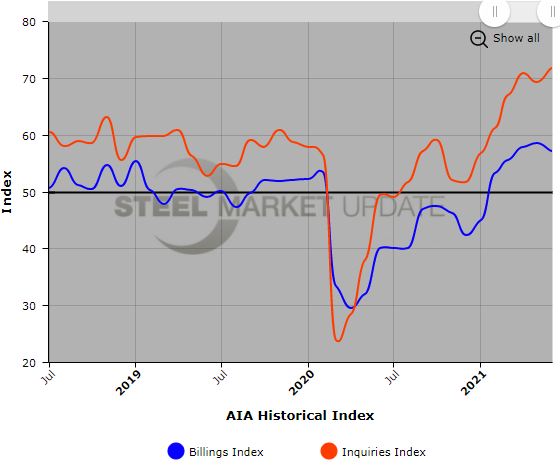Economy

Architectural Billings Index Remains Positive in June
Written by David Schollaert
July 22, 2021
Demand for design services from U.S. architecture firms continued to increase in June, said the American Institute of Architects. AIA’s Architecture Billings Index reached 57.1 in the month, 1.4 points lower than May but still in growth territory. The billings index has expanded every month since January.
The index for new design contracts declined 4.3 points from the May record high to 58.9. The new projects inquiry index increased to a record high of 71.8, surpassing the previous high of 70.8 in April 2021.
“With the current pace of billings growth near the highest levels ever seen in the history of the index, we’re expecting a sharp upturn in nonresidential building activity later this year and into 2022,” said AIA Chief Economist Kermit Baker. “However, as is often the case when market conditions make a sudden reversal, concerns are growing about architecture firms not being able to find enough workers to meet the higher workloads. Nearly six in 10 firms report that they are having problems filling open architectural staff positions.”
Regional billing readings remained positive in June, although three out of four regional billing scores declined from the month prior: Midwest declined to 62.0, South declined to 57.3 and Northeast declined to 53.2. The West increased to 59.7.
By sector, scores increased for the commercial/industrial sector (61.0) and institutional sector (57.3), while scores declined in the multifamily residential sector (57.9) and the mixed practice sector (56.4).
The Architecture Billings Index is an economic indicator for nonresidential construction activity, with a lead time of approximately 9-12 months. A score above 50 indicates an increase in activity, and a score below 50 a decrease.
Below is a graph showing the history of the AIA Architecture Billings Index. You will need to view the graph on our website to use its interactive features; you can do so by clicking here. If you need assistance logging into or navigating the website, please contact us at info@SteelMarketUpdate.com.


David Schollaert
Read more from David SchollaertLatest in Economy

New York state manufacturing index drops again in April
Firms were pessimistic, with the future general business conditions index falling to its second lowest reading in the more than 20-year history of the survey

Construction adds 13,000 jobs in March
The construction sector added 13,000 jobs, seasonally adjusted, in March, but tariffs could undermine the industry.

Supply chains, end-users brace for impact from tariffs
Supply chains are working through what the tariffs mean for them

ISM: Manufacturing expansion loses steam after two months of growth
US manufacturing activity slowed in March after two straight months of expansion, according to supply executives contributing to the Institute for Supply Management (ISM)’s latest report.

Chicago Business Barometer rose to 16-month high in March
The Chicago Business Barometer increased for the third-consecutive month in March. Despite this, it still reflects contracting business conditions, as it has since December 2023.
